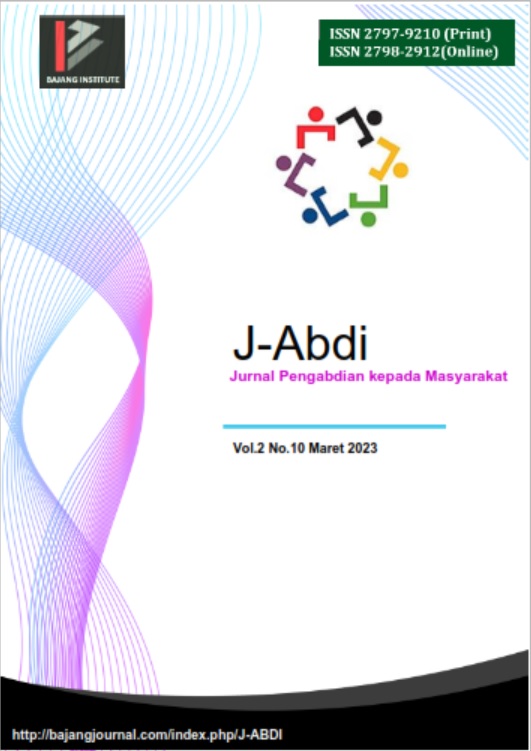WORKSHOP COILING EXERCISES ON TENNIS SPIN SERVE WITH KINOVEA
DOI:
https://doi.org/10.53625/jabdi.v2i10.5190Keywords:
Coiling Exercise, Serve Tennis, Spin Serve, KinoveaAbstract
The main problem is that service is only considered as the beginning of a match. When in fact service is a very important thing in a match, because service is a fast way to get points. One important part of the tennis serve is the skill of coiling or body rotation. The purpose of this service is to provide coiling exercises that are analyzed kinovea application. This service is carried out for 6 weeks with a frequency of 3 times per week. At the beginning and at the end of the meeting the partners' coiling skills were analyzed using the kinovea app. Partners are 30 South Sulawesi novice tennis athletes aged 14-16 years. The result of this dedication was an average increase in coiling skills of 1,267. So this service is necessary in improving coiling skills in order to be able to score points quickly in a match of tennis.
References
Aprilo, I., M. Asmawi, and J. Tangkudung. “Concept Development on Spin Serve Exercise Model of Lawn Tennis Based Kinovea.” Proceedings of the 1st International Conference on Advanced Multidisciplinary Research (ICAMR 2018) (2019): 28–33.
Aprilo, I, M Asmawi, and J Tangkudung. “The Effectivenes of Exercise Spin Serve Model.” JIPES (2021).
Aprilo, Ians, Moch. Asmawi, and James Tangkudung. “Concept Development on Spin Serve Exercise Model of Lawn Tennis Based Kinovea.” In Proceedings of the 1st International Conference on Advanced Multidisciplinary Research (ICAMR 2018), 28–33. Makassar, Indonesia: Atlantis Press, 2019.
———. “Kinovea-Based : Tennis Spin Serve Analysis.” Journal of Physical Education, Sport, Health and Recreations 11, no. 2 (2022): 7985.
———. Metode Latihan Servis Spin Tenis Lapangan Berbasis Kinovea. Jakarta: Pascasarjana Universitas Negeri Jakarta, 2019.
———. “THE EFFECTIVENESS OF EXERCISE SPIN SERVE MODEL ON LAWN TENNIS BASED KINOVEA” 7, no. 1 (2021): 14–27.
Arimbi, Poppy Elisano Arfanda, Nurliani, and Wahyana Mujari Wahid. “Workshop Gizi Olahraga : Pengaturan Makan Atlet.” Jurnal Pengabdian Kepada Masyarakat 2, no. 7 (2020): 5547–5552. https://bajangjournal.com/index.php/J-ABDI/article/view/3994.
Dhinesh, R., S. P. Preejith, and Mohanasankar Sivaprakasam. “Tennis Serve Correction Using a Performance Improvement Platform.” 2018 IEEE 6th International Conference on Serious Games and Applications for Health, SeGAH 2018 (2018): 1–7.
Hornestam, Joana Ferreira, Thales Rezende Souza, Fabrício Anício Magalhães, Mickäel Begon, Thiago Ribeiro Teles Santos, and Sérgio Teixeixa Fonseca. “The Effects of Knee Flexion on Tennis Serve Performance of Intermediate Level Tennis Players.” Sensors 21, no. 16 (2021): 1–10.
Hoskins-Burney, T., and L. Carrington. The Tennis Drill Book, 2E. Human Kinetics, 2014.
Jung, Kooin, and Haneol Kim. “Comparison of the Tennis Serve Performance: A Case Study of an Elite Korean Tennis Player.” International Journal of Human Movement Science 16, no. 1 (2022): 77–85.
Sakurai, Shinji, Machar Reid, and Bruce Elliott. “Ball Spin in the Tennis Serve: Spin Rate and Axis of Rotation.” Sports Biomechanics 12, no. 1 (2013): 23–29.
Wu, Guodong. “Monitoring System of Key Technical Features of Male Tennis Players Based on Internet of Things Security Technology.” Wireless Communications and Mobile Computing 2021 (2021).
Yu, Kaiyang, Yingxiang Gong, and Zile Fan. “A Battery-Free Pressure Sensing System Based on Soft Piezoelectric Device for Tennis Training.” Mechanika 28, no. 3 (2022): 237–241.














